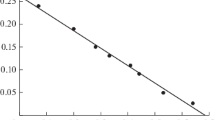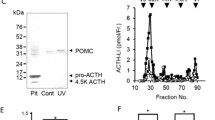Abstract
The neuropeptides substance P (SP), calcitonin gene-related peptide (CGRP) and α-melanocyte-stimulating hormone (α-MSH) are known to be able to regulate the production of cytokines in the skin. Since IL-8 plays an important role in cutaneous inflammation, the effects of SP, CGRP and α-MSH on the IL-8/IL-8 receptor (IL-8RA) systems of these cell types were studied. Cultures of human dermal fibroblasts and an immortalized keratinocyte cell line HaCaT were treated with 10−8 M SP, CGRP or α-MSH. The results demonstrated that these neuropeptides have different effects on the IL-8 and IL-8RA expressions of the cells. SP and CGRP upregulated the IL-8RA mRNA expression in HaCaT cells, but had no influence on their IL-8 production, whereas, α-MSH had no effect on either the IL-8 or the IL-8RA mRNA expression in HaCaT cells. In contrast, α-MSH resulted in a time-dependent induction of the IL-8 mRNA expression in dermal fibroblasts. This induction was already detectable after 6 h, and after 12 h there was a 5-fold change in comparison with the controls. The IL-8 content of the supernatant was also increased, with a maximum at 48 h after α-MSH treatment. The data established in the present study support the notion that neuropeptides can directly modulate the IL-8/IL-8RA system of keratinocytes and fibroblasts.
Similar content being viewed by others
REFERENCES
Pincelli, C., F. Fantini, and A. Gianetti. 1993. Neuropeptides and skin inflammation. Dermatology 187:153-158.
Eedy, D. J. 1993. Neuropeptides in skin. Brit. J. Dermatol. 128:597-605.
Lotti, T., G. Hautmann, and E. Panconesi. Neuropeptides in skin. Clinical review. 1995. J. Am. Acad. Dermatol. 33:482-496.
Wallengren, J., R. Ekman, and F. Sundler. Occurrence and distribution of neuro-peptides in the human skin. 1987. Acta Dermato-Venereol. (Stockh) 67:185-192.
Slominski, A., J. Worstman, J. E. Mazurkiewicz, L. Matsuoka, J. Dietrich, K. Lawrence, A. Gorbani, and R. Paus. 1993. Detection of proopiomelanocortin-derived antigens in normal and pathologic human skin. J. Lab. Clin. Med. 122:482-496.
Eedy, D. J., C. F. Johnston, C. Shaw, and K. D. Buchanan. 1991. Neuropeptides in psoriasis: An immunohistochemical and radioimmunoassay study. J. Invest. Dermatol. 96:434-438.
Gianetti, A., F. Fantini, A. Cimitan, and C. Pincelli. 1992. Vasoactive intestinal polypeptide and substance P in the pathogenesis of atopic dermatitis, Acta Dermato-Venereol. (Stockh) Suppl. 176:90-92.
Bull, H. A., J. Hothersall, N. Chowdhury, J. Cohen, and P. M. Dowd. 1996. Neuropeptides induce release of nitric oxide from human dermal microvascular endothelial cells. J. Invest. Dermatol. 106:655-660.
KemÉny, L., B. Restorff, G. Michel, and T. Ruzicka. 1994. Specific binding and lack of growth-promoting activity of substance P in cultured keratinocytes. J. Invest. Dermatol. 103:605-606.
Brown, J., P. Perrz, S. Hofeneider, and J. Ansel. 1990. Neuropeptide modulation of keratinocyte cytokine production. In: Oppenheim, Powanda, Kluger, Dinarello (Editors), Molecular and Cellular Biology of Cytokines. Wiley-Liss, Inc., pp. 451-456.
Nilsson, J., A. von Euler, and C-J. Dalsgaard. 1985. Stimulation of connective tissue cell growth by substance P and substance K. Nature 315:61-65.
Ziche, M., L. Morbidelli, M. Pacini, P. Geppetti, and G. Alesandri. 1990. Substance P stimulated neovascularization in vivo and proliferation of cultured endothelial cells. Microvascular. Res. 40:264-266.
Naukkarinen, A., I. Harvima, K. Paukkonen, M-L. Aalto, and M. Horsmanheimo. 1993. Immunohistochemical analysis of sensory nerves and neuropeptides, and their contacts with mast cells in developing and mature psoriatic lesions. Arch. Derm. Res. 285:341-346.
Hosoi, J., G. F. Murphy, C. L. Egan, E. A. Lerner, S. Grabbe, A. Asahina, and R. D. Granstein. 1993. Regulation of Langerhans cell function by nerves containing calcitonin generalted peptide. Nature 363:159-163.
Slominski, A., R. Paus, and J. Mazurkiewicz. 1993. On the potential role of proopiomelanocortin in skin physiology and pathology. Mol. Cell. Endocrinol. 93:C1-C6.
Pears, J. S., R. T. Jung, W. Bartlett, M. C. K. Browning, K. Kenicer, and A. J. Thody. 1992. A case of hyperpigmentation due to α-MSH hypersecretion. Brit. J. Dermatol. 26:286-289.
Kock, A., E. Schauer, T. Schwarz, and T. Luger. 1990. MSH and ACTH production by human keratinocytes. A link between the neuronal and immune system. J. Invest. Dermatol. 94:543(A).
KemÉny, L., A. Sz. Kenderessy, E. Olasz, G. Michel, T. Ruzicka, and A. Dobozy. 1994. The interleukin-8 receptor: a potential target for antipsoriatic therapy. Eur. J. Pharmacol. 258:269-272.
Parenti, A., S. Amerini, F. Ledda, and C. A. Maggi. 1996. The tachykinin NK1 receptor mediates the migration-promoting effect of substance P on human skin fibroblasts in culture. Naunyn-Schmiedeberg Arch. Pharmacol. 353:475-481.
Proudfoot, A. E. I. 1998. The chemokine family. Potential therapeutic targets from allergy to HIV infection. Review. Eur. J. Dermatol. 8:147-157.
Fleischmajer, R., J. S. Perlish, T. Krieg, and R. Timpl. 1981. Variability in collagen and fibronectin synthesis by scleroderma fibroblasts in primary culture. J. Invest. Dermatol. 76:400-403.
Matsushima, K., and J. Oppenheim. 1989. Interleukin 8 and MCAF: Novel inflammatory cytokines inducible by IL-1 and TNF. Cytokine 1:2-12.
Holmes, W. E., J. Lee, W-J. Kuang, C. Rice, and W. I. Wood. 1991. Structure and functional expression of a human interleukin-8 receptor. Science 253:1278-1280.
Nakajima-Iijima, S., H. Hamada, P. Reddy, and T. Kakunaga. 1985. Molecular structure of the human cytoplasmic beta-actin gene: interspecies homology of sequences in the introns. Proc. Natl. Acad. Sci. U.S.A. 82:6133-6137.
Schoop, V. M., M. Mirancea, and N. E. Fusenig, 1999. Epidermal organization and differentiation of HaCaT keratinocytes in organotypic cocultures with human dermal fibroblasts. J. Invest. Dermatol. 112:545-555.
Viac, J., A. GuÉniche, J. D. Doutremepuich, U. Reichert, A. Claudy, and D. Schmitt. 1996. Substance P and keratinocyte activation markers: an in vitro approach. Arch. Dermatol. Res. 288:85-90.
Schulz, B., G. Michel, S. Wagner, R. SÜss, A. Beetz, R. U. Peter, L. KemÉny, and T. Ruzicka. 1993. Increased expression of epidermal IL-8 receptor in psoriasis. Down-regulation by FK-506 in vitro. J. Immunol. 151:4399-4406.
Weddel, G., H. A. Cowan, E. Palmer, and S. Ramaswamy. Psoriatic skin. 1965. Arch. Dermatol. 91:252-256.
Mohamadzadeh, M., M. Muller, T. Hultsch, A. Enk, J. Saloga, and J. Knop. 1994. Enhanced expression of IL-8 in normal human keratinocytes and human keratinocyte cell line HaCaT in vitro after stimulation with contact sensitizers, tolerogens and irritants. Exp. Dermatol. 3:298-303.
Mauviel, A., S. Reitamo, A. Remitz, J. C. Lapiere, M. Ceska, M. Baggiolini, A. Walz, C. H. Evans, and J. Uitto. 1992. Leukoregulin, a T cell-derived cytokine, induces IL-8 gene expression and secretion in fibroblasts. Demonstration of enhanced NF-kappa B binding and NF-kappa B-driven promoter activity. J. Immunol. 149:2969-2976.
Kiss, M., M. Wlaschek, P. Brenneisen, G. Michel, C. Hommel, T. S. Lange, D. Peus, L. KemÉny, A. Dobozy, K. Scharffetter-Kochanek, and T. Ruzicka. 1995. α-Melanocyte stimulating hormone induces collagenase-matrix-metalloproteinase-1 in human dermal fibroblasts. Biol. Chem. Hoppe-Seyler 376:425-430.
Unemori, E. N., E. P. Amento, E. A. Bauer, and R. Horuk. 1993. Melanoma growth-promoting activity/GRO decreases collagen expression by human fibroblasts. Regulation by C-X-C but not C-C cytokines. J. Biol. Chem. 268:1138-1342.
Author information
Authors and Affiliations
Rights and permissions
About this article
Cite this article
Kiss, M., Kemény, L., Gyulai, R. et al. Effects of the Neuropeptides Substance P, Calcitonin Gene-Related Peptide and α-Melanocyte-Stimulating Hormone on the IL-8/IL-8 Receptor System in a Cultured Human Keratinocyte Cell Line and Dermal Fibroblasts. Inflammation 23, 557–567 (1999). https://doi.org/10.1023/A:1020294507767
Issue Date:
DOI: https://doi.org/10.1023/A:1020294507767




